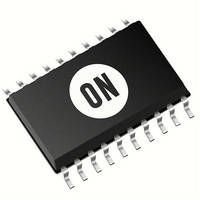NCP1081DER2G ON Semiconductor, NCP1081DER2G Datasheet - Page 11

NCP1081DER2G
Manufacturer Part Number
NCP1081DER2G
Description
IC CONV CTLR POE-PD 40W 20-TSSOP
Manufacturer
ON Semiconductor
Type
Power over Ethernet Switch (PoE)r
Datasheet
1.NCP1081DER2G.pdf
(17 pages)
Specifications of NCP1081DER2G
Applications
Remote Peripherals (Industrial Controls, Cameras, Data Access)
Internal Switch(s)
Yes
Current Limit
1.1A
Voltage - Supply
0 V ~ 57 V
Operating Temperature
-40°C ~ 85°C
Mounting Type
Surface Mount
Package / Case
20-TSSOP Exposed Pad, 20-eTSSOP, 20-HTSSOP
Output Voltage
9 V
Switching Frequency
250 KHz
Maximum Operating Temperature
+ 85 C
Mounting Style
SMD/SMT
Minimum Operating Temperature
- 40 C
Operating Temperature Range
- 40 C to + 85 C
Output Power
40 W
Input Voltage
57V
Supply Current
510mA
Digital Ic Case Style
TSSOP
No. Of Pins
20
Duty Cycle (%)
80%
Uvlo
38V
Frequency
500kHz
Svhc
No SVHC (20-Jun-2011)
Rohs Compliant
Yes
Lead Free Status / RoHS Status
Lead free / RoHS Compliant
Available stocks
Company
Part Number
Manufacturer
Quantity
Price
Company:
Part Number:
NCP1081DER2G
Manufacturer:
IXYS
Quantity:
7 710
Powered Device Interface
IEEE 802.3af and draft IEEE802.3at (D3.0) defined
operating modes: detection signature, current source
classification, inrush, and operating current limits. In order
to give more flexibility to the user and also to keep control
of the power dissipation in the NCP1081, both current limits
are configurable. The device enters operation once its
programmable Vuvlo_on threshold is reached, and
operation ceases when the supplied voltage falls below the
Vuvlo_off threshold. Sufficient hysteresis and Uvlo filter
time are provided to avoid false power on/off cycles due to
transient voltage drops on the cable.
Detection
resistance seen by the PSE through the cable must be in the
IEEE 802.3af standard specification range (23.75 kW to
26.25 kW) for a PSE voltage from 2.7 V to 10.1 V. In order
to compensate for the non−linear effect of the diode bridge
and satisfy the specification at low PSE voltage, the
NCP1081 presents a suitable impedance in parallel with the
25.5 kW Rdet external resistor. For some types of diodes
(especially Schottky diodes), it may be necessary to adjust
this external resistor.
11.5 V) on VPORTP, the NCP1081 turns on its internal
3.3 V regulator and biasing circuitry in anticipation of the
classification phase as the next step.
Classification
classification process begins. The NCP1081 is fully capable
of responding and completing all classification handshaking
procedures as described next.
Classification Current Source Generation
source that is set by the external resistor RCLASS value on
the CLASS pin. Figure 6 shows the schematic overview of
the classification block. The current source is defined as:
The PD interface portion of the NCP1081 supports the
During the detection phase, the incremental equivalent
When the Detection_Off level is detected (typically
Once the PSE device has detected the PD device, the
In classification, the PD regulates a constant current
Rclass
VPORTN1,2
VPORTP
CLASS
Figure 6. Classification Block Diagram
I
class
+
R
V
class
bg
, (where V
VDDA1
bg
NCP1081
is 1.2 V)
1.2 V
Description of Operation
http://onsemi.com
11
classification, IEEE 802.3af, draft IEEE802.3at (D3.0) and
proprietary classification.
performed with a Single Event Layer 1 classification.
Depending on the current level set during that single event
the power level is determined. The current draft
IEEE802.3at (D3.0) allows two ways of classification
which can also be combined. These two approaches enable
higher power applications through a variety of PSE
equipment.
hardware handshake is introduced called Two Event
Layer 1 classification. This approach allows equipment
that has no data link between PSE and PD to classify as high
power.
PD, a software handshake is possible. This type of
handshake is called Layer 2 classification (or Data Link
Layer classification). It has the main advantage of having a
finer power resolution and the ability for the PSE and PD to
participate in dynamic power allocation.
One Event Layer 1 Classification
Event Layer 1 classification event by increasing the line
voltage into the classification range only once.
Two Event Layer 1 Classification
physical classification performs two classification events
and looks for the appropriate response from the PD to check
if the PD is draft IEEE802.3at (D3.0) compatible.
Figure 7. During the first classification finger, the PSE will
measure the classification current which should be 40 mA
if the PD is at compliant. If this is the case, the PSE will exit
the classification range and will force the line voltage into
the Mark Event range. Within this range, the PSE may check
the non−valid input signature presented by the PD (using the
two point measurement defined in the IEEE 802.3af
standard). Then the PSE will repeat the same sequence with
the second classification finger. A PD which has detected the
sequence “Finger + Mark + Finger + Mark” knows the PSE
is draft IEEE802.3at (D3.0) compliant, meaning the PSE
will deliver more current on the port. (Note that a PSE draft
Table 4. Single and Dual Event Classification
Standard
802.3af
802.3at
802.3at
The NCP1081 can handle all defined types of
In the IEEE 802.3af standard the classification is
For power injectors and midspans a pure physical
Since switches can establish a data link between PSE and
An IEEE 802.3af compliant PSE performs only One
A draft IEEE802.3at (D3.0) compliant PSE using this
The PSE will generate the sequence described in
Layer
1
1
2
Single event physical classification
Two event physical classification
Data−link (IP) communication
classification
Handshake








